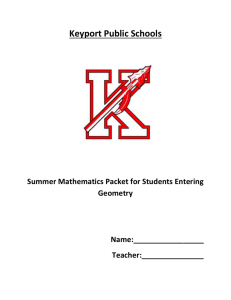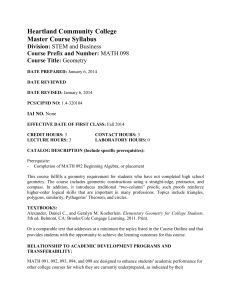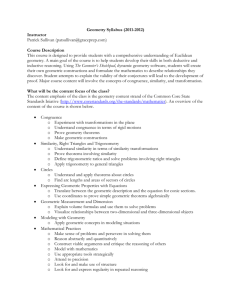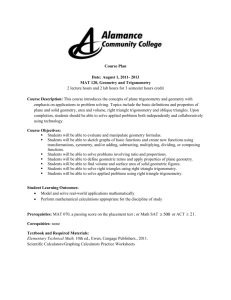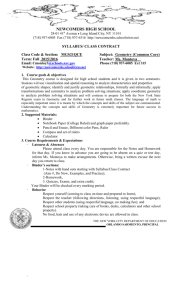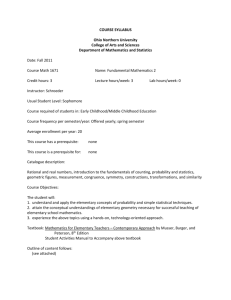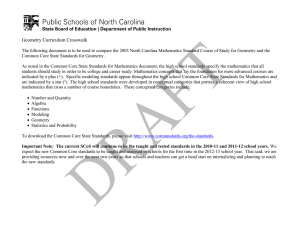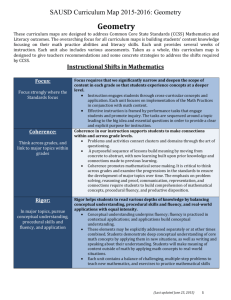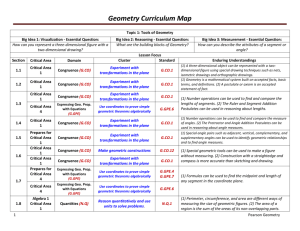This is the Geometry 2015
advertisement
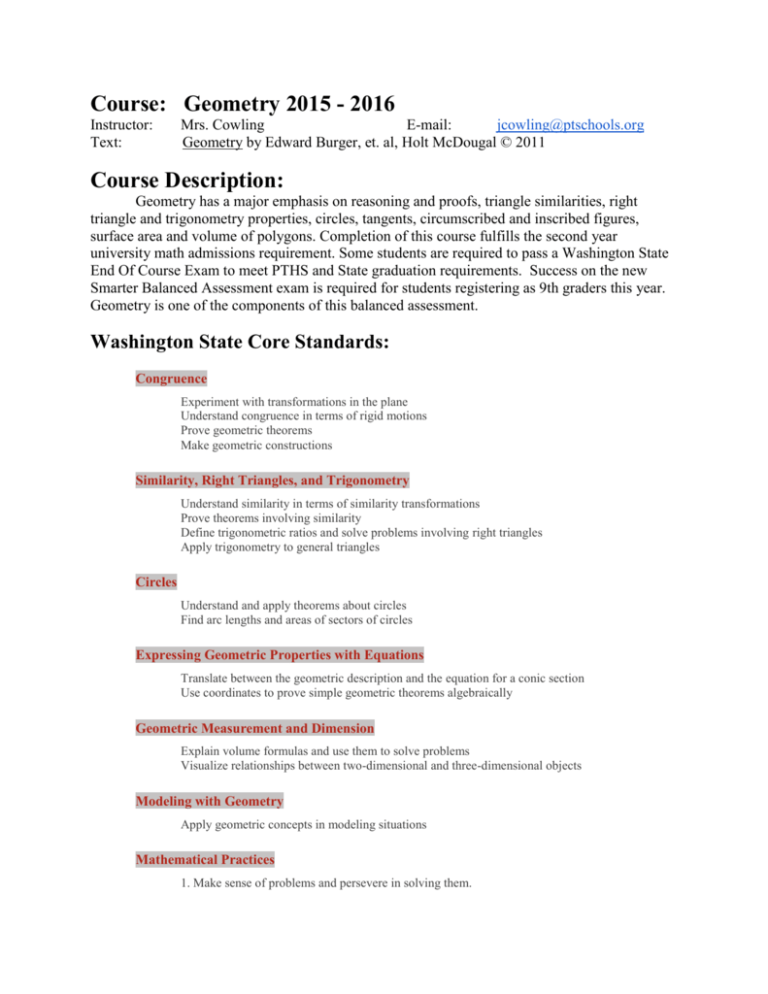
Course: Geometry 2015 - 2016 Instructor: Text: Mrs. Cowling E-mail: jcowling@ptschools.org Geometry by Edward Burger, et. al, Holt McDougal © 2011 Course Description: Geometry has a major emphasis on reasoning and proofs, triangle similarities, right triangle and trigonometry properties, circles, tangents, circumscribed and inscribed figures, surface area and volume of polygons. Completion of this course fulfills the second year university math admissions requirement. Some students are required to pass a Washington State End Of Course Exam to meet PTHS and State graduation requirements. Success on the new Smarter Balanced Assessment exam is required for students registering as 9th graders this year. Geometry is one of the components of this balanced assessment. Washington State Core Standards: Congruence Experiment with transformations in the plane Understand congruence in terms of rigid motions Prove geometric theorems Make geometric constructions Similarity, Right Triangles, and Trigonometry Understand similarity in terms of similarity transformations Prove theorems involving similarity Define trigonometric ratios and solve problems involving right triangles Apply trigonometry to general triangles Circles Understand and apply theorems about circles Find arc lengths and areas of sectors of circles Expressing Geometric Properties with Equations Translate between the geometric description and the equation for a conic section Use coordinates to prove simple geometric theorems algebraically Geometric Measurement and Dimension Explain volume formulas and use them to solve problems Visualize relationships between two-dimensional and three-dimensional objects Modeling with Geometry Apply geometric concepts in modeling situations Mathematical Practices 1. Make sense of problems and persevere in solving them. 2. Reason abstractly and quantitatively. 3. Construct viable arguments and critique the reasoning of others. 4. Model with mathematics. 5. Use appropriate tools strategically. 6. Attend to precision. 7. Look for and make use of structure. 8. Look for and express regularity in repeated reasoning. Course Outline 2015-2016: 1. Foundations for Geometry: Undefined terms, points, lines & planes. Measurement and construction of segments and angles. Distance Formula and Pythagorean Theorem application and Coordinate Plane Transformations. 2. Circles: Lines, Arcs, Angles and Segments in Circles 3. Geometric Reasoning: Inductive and Deductive Reasoning as well as Algebraic and Geometric Proofs 4. Parallel and Perpendicular Lines: lines with transversals, Coordinate Geometry 5. Triangle Congruence: Classifying Triangles, Proving Triangle Congruence 6. Properties and Attributes of Triangles: Segments in Triangles, Relationships in Triangles 7. Polygons and Quadrilaterals: Properties and Attributes of Polygons, Especially Quadrilaterals. 8. Similarity: Ratio, Proportion, Triangle Similarity 9. Right triangles and Trigonometry: Similarity in Right Triangles, Trigonometric Ratios, Law of Sines and Cosines 10. Extending Perimeter, Circumference, and Area: Developing Geometric Formulas for use in the Coordinate Plane 11. Spatial Reasoning: Three-Dimensional Figures, Surface Area and Volume 12. Extending Transformational Geometry: Congruence Transformations. Patterns Grading: Since the grade a student earns should represent their level of understanding, assignments focused on skill development (Notebook entries and formative assessments) will have a minimal impact on the student’s grade. Assignments representing the student’s individual level of understanding (i.e. tests) will have a greater impact. The total points accumulated in the following weighted categories will determine the student’s overall grade: 10% Classroom participation and Individual Responsibility 15% Student Notebook (daily work, worksheets, independent work and assigned problems) 10% Quizzes and Formative Assessments 65% Tests/Final Required Materials: 1. 2. 3. 4. Dedicated Math Notebook, folder, or loose leaf notebook storage organizer, Pencil, pen, and colored pencils, Compass, protractor, ruler with both metric and standard rulings, Calculator capable of doing scientific notation and trigonometry functions, Suggested: highlighters, post-it notes. Classroom Expectations for Success: 1. Be Prepared – Bring Notebook of preference, pen/pencil, calculator and geometry tools to class EVERYDAY. 2. Be Prompt – You should be seated, quiet, and ready to work when class begins. The PTHS Tardy policy will be enforced. 3. Be Polite – Respect yourself and others through your words and actions. 4. Be Positive – Attitude is a little thing that makes a BIG difference. You can do it! 5. Be Productive – Work the entire class period and stay on-task without distracting others. Keep personal electronic devices silent and stowed. Absence/Attendance: Work missed due to illness or other reasons will need to be made up. Math concepts and skills are built upon prior knowledge and are sequenced similar to walking up a staircase. Students are responsible for making up the assignments and content from missed class periods. Some ideas for catching up include: 1. Look at another student’s notes, 2. Pick up all papers and the agenda from missed days, 3. Complete assignments to the best of your ability, 4. Schedule a time with the teacher to get assistance. Students should schedule time before or after school to makeup a missed quiz or test due to an excused absence. Late/Missing/Retaking Assessments It is essential for success in Geometry that students develop good study habits by completing quality work consistently. Prior to each unit, an organization chart will be prepared, passed out and posted on the school website. If dates of prior arranged absences are known, make arrangements to do work early and get questions resolved as soon as possible. In the event that your test score is not your best work, tests can be taken again in order for students to demonstrate a better understanding of the material being assessed. Retake tests must be scheduled by the student before or after school. Students must verify that additional work has been completed in order to improve understanding of the material being addressed. Additional work must be turned in prior to setting a retest appointment; I must verify that the additional work demonstrates students can problem solve independently. Extra Work Due to my belief that grades should reflect a student’s level of understanding I rarely give extra credit in the traditional sense. Instead of extra credit I will allow retakes on tests and lesson quizzes. Extra work will need to be done ahead of time to prepare for the reexamination. Retakes need to be done before or after school by appointment. The new score, if better than the original, will replace the previous score to reflect the student’s new level of understanding. Communication: Students – The emphasis in this class, and in your grades, is to improve upon where you started from and continually grow. You are only limited by the effort you are willing to put forth to earn the grade you want. Success in Geometry is more than your mathematical knowledge. It’s also about your ability to focus, persevere, ask for help when you need it, and develop the skills necessary to critically analyze spatial and logical problems. Please e-mail me if you are stuck on something while you are doing your independent work. I will either send you a message back, or address the question in class the next day (others will most likely have a question similar to yours). Need face-to-face help? I’m here to help. Before school 7:35am – 8:00am During lunch time by appointment After school until 4:00-ish if no faculty meeting is scheduled Parents – The best tool to stay informed is the Family Access/Skyward online program that can be accessed through the school’s website, http://www.ptschools.org. Please contact the main office for correct login and password. Grades are updated on a regular basis. I am looking forward to a year of growth with your student. Please sign and return this section of the Geometry syllabus. This is your first assignment contributing to personal responsibility grade category.Once signed, the syllabus in your notebook. My signature below indicates my awareness of the policies and guidelines within this document. Please sign and include your e-mail address. E-mail is my preferred way to stay in touch with you! __________________________________ Parent Name (print) _________________________________ Parent E-mail Address _________________________________ Parent Phone Number __________________________________ _________________________________ Student Name (print) Student E-mail Address Other comments, questions, things you think I should know:
